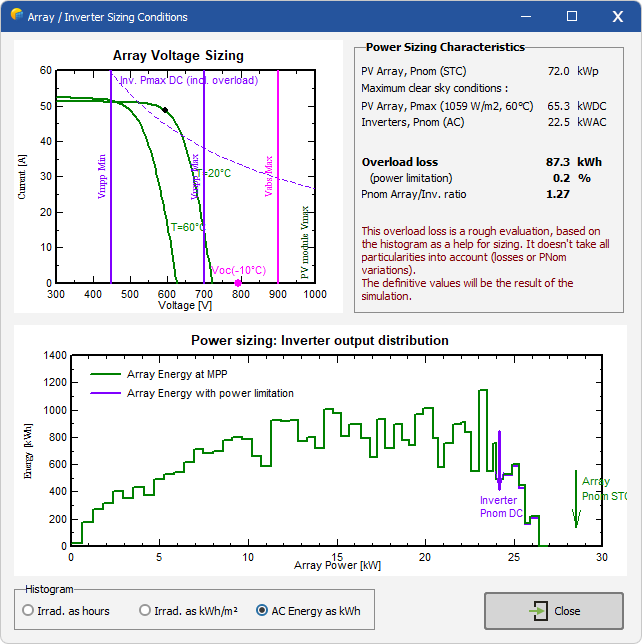|
<< Click to Display Table of Contents >> Inverter / Array sizing |
  
|
|
<< Click to Display Table of Contents >> Inverter / Array sizing |
  
|
The inverter power sizing is a delicate and debated problem.
Many inverter providers recommend (or require) a PNom array limit or a fixed Pnom (inverter / array) ratio, usually of the order of 1.0 to 1.1.
PVsyst provides a much more refined and reliable procedure.
Preliminary observations about Pnom sizing
| 1. - | The Pnom of the inverter is defined as the output AC power. The corresponding input power is PnomDC = PnomAC / Efficiency, i.e. about 3 to 6% over. For example a 10 kW inverter will need PNomDC=10.5 kW input for operating at 10 kWac. |
| 2. - | The Pnom of the array is defined for the STC. But in real conditions, this value is very rarely or never attained. The power under 1000 W/m² and 25°C is equivalent to that produced under 1120 W/m² and 55°C with μPmpp = -0.4%/°C. Such an irradiance is only reached episodically in most sites. |
| 3. - | The power distribution is dependent on the plane orientation: a façade will never receive more than 700-800 W/m², depending on the latitude. |
| 4. - | The maximum powers are not very dependent on the latitude: by clear day and perpendicular to the sun rays, the irradiance is quite comparable, only dependent on the air mass. But it significantly depends on the altitude. |
| 5. - | Many inverters accept a part of overload specified by a Pmax parameter, during short times (dependent on the temperature of the device). This is not taken into account in the simulation, and may still reduce the calculated overload loss, |
| 6. - | When over-sized, the inverter will operate more often in its low power range, where the efficiency is decreasing. |
Sizing principle
In PVsyst, the inverter sizing is based on an acceptable overload loss during operation, and therefore involves estimations or simulations in the real conditions of the system (meteo, orientation, losses).
Taking the following into account:
| A. - | Overload behaviour: With all modern inverters, when the Pmpp of the array overcomes its PnomDC limit, the inverter will stay at its safe nominal power by displacing the operating point in the I/V curve of the PV array (towards higher voltages). Therefore it will not undertake any overpower; simply the potential power of the array is not produced. There is no power to dissipate, no overheating and therefore no supplementary ageing. |
| B. - | Loss evaluation: In this mode the only energy loss is the difference between the Pmpp "potential" power and the PnomDC limit effectively drawn. We can see on the power distribution diagrams, that even when the inverter's power is a little bit under the maximum powers attained by the array in real operation, this results in very little power losses (violet steps with respect to the green ones, quasi-invisibles). The simulation - and the analysis of the overload loss - is therefore a very good mean for assessing the size of an inverter. |
This is shown on the power histogram in the "System" definitions, button "Show sizing".

The PVsyst criteria for an acceptable sizing are specified in the project's definition (button "Albedo and Settings", item "Limit of Overload loss for design") and the default values are in the Hidden parameters (topic "Detailed Simulation Verification Conditions", items "Acceptable/Limit overload loss for design"): by default:
| 3% > Overload Loss > 0.2% : | inverter slightly undersized, warning (orange colour) |
| Overload loss > 3%: | inverter strongly undersized, prevents the simulation. |
In practice these criteria lead to Pnom Ratio (Pnom(Array) / Pnom(Inv), also named DC:AC ratio) of the order of 1.25 to 1.3 for most well-oriented systems (Pnom ratio > 2 for façades!). This ratio may become much higher when the inverter's nominal power can be increased up to a value PMax at low temperatures).
For an economical optimization, the final overpower losses are to be put in balance with the price difference with an inverter of higher power. These considerations often lead to significantly undersized inverters with respect to the manufacturer's recommendations.
Due to special policies (limitation of the injected power by the grid manager) more and more systems are using a strongly oversized PV array.
Please note that the simulation's results (Overload loss) may be significantly different from this sizing value (they show usually lower losses). This is because the elaboration of the histogram for this rough sizing tool cannot take all the system losses into account. The reference result will of course be the result of the detailed hourly simulation.